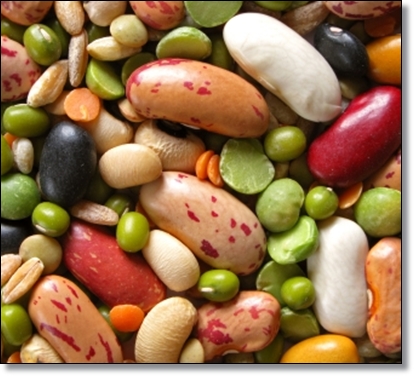Legume Boom in Western Kenya Spurs Farmers to Bulk Seed

 |
In Western Kenya, the looming economic boom of Soya, Groundnuts and Cowpeas legumes has spurred more farmers who traditionally grew maize and beans to diversify. Through Community Based Organizations (CBOs) and research institutions, farmers are bulking seeds of these high value legumes that are also value addition friendly enough, to earn them extra incomes locally.
The seed bulking is part of a 3 year initiative begun in 2009 in Busia, Siaya and Teso Districts and aimed at fighting food insecurity among the 15,000 SHFs targeted. Though the regions have potential to produce enough food, few residents manage to have 3 square meals daily. Already, Soya farming looks economically promising for the regions, and Appropriate Rural Development Agricultural Program (ARDAP) is working with farmers to build up adequate legume seed stock.
Since ARDAP started out with the farmers in 2009, they have bulked soya seed in 8.4 hectares, groundnuts in 4 hectares and cowpeas in nearly a hectare. In the regions, “farmers have difficulties getting quality soya seed,” said Joseph Ambiya an enthusiastic start up soya farmer. He is one of the beneficiaries of the bulking and he got into soya farming the first time last year in April.
The scarcity of soya seed in many agro-dealerships in Kenya is due to reluctance by seed companies to multiply it according to Dr Martins Odendo an agro-economist with Kenya Agricultural Research Institute (KARI) - Kakamega . Crops like legumes are not good for business to the companies as farmers reuse the seed for successive seasons unlike crops like maize where seed recycling results in low yields. That means farmers have to buy maize seeds every season to the benefit of the companies. “This reluctance affects many so called orphan crops,” added Dr Odendo.
KARI Kakamega which breeds the certified seed lacks the capacity to meet the demands of all farmers. That is why currently, legume seed bulking among farmers has become necessary. KARI through ARDAP avails the certified seed to farmers who multiply for their use. This arrangement is countering problems of late planting and is lowering the costs of accessing the seeds by small holder farmers.
According to Boniface Omondi, a technical officer with ARDAP, farmers are given quality soya seed from KARI Kakamega by ARDAP for free to grow. If a farmer is given 2kgs of Soya to grow, he is expected on harvest to give back to 4kgs. Of the 4kgs, 2kgs goes to the ARDAP Soya seed reserve and 2kgs goes to any new interested Soya farmer. Farmers in groups of 25 to 50 members can recruit friends by giving them Soya seeds for free to grow.
So far, the project has proved a success to recruiting new soya farmers and adding soya seed to the bank. Currently 3000 farmers this year have been added to the initiative. Seed recovery has also been encouraging “we have had 90 percent recovery rate,” said Omondi. The recovery is done in seed ceremonies for accountability and ease of follow up. Here Soya farmers gather and payback the seeds and an ARDAP officer records and prospective soya farmers there get free seeds.
The ceremony also doubles as a learning event. Farmers are taught value addition, Integrated Soil Fertility Management (ISFM) to ensure they know the primary benefits they will accrue from growing legumes like Soya which fix vital nutrients like nitrogen to the soil. As the seed bulking project grows there have been positives evident in farmlands too. Farmers growing Soya report that it’s suppressing weeds like Striga and Richardia Scabra. The two are an evidence of soil infertility and their effect on farmlands in the 3 regions has been low yields, less than a tonne of maize or legumes per hectare.
“The soils are highly weathered and low in nutrients,” said Dr Bashir Jama the Director of Soil Health Program at Alliance for Green Revolution Africa (AGRA) who provide funds for outreaches to farmers by local CBOs. In the project there have been incidences where farmers tend the legumes poorly and harvests are low and farmers can’t payback their seed.
He emphasizes farmers incorporate good agronomic practices into their farming in order to get high legume yields. According to Dr Bashir to get the high yields farmers should incorporate the 4 Rs - apply right fertilizer at right rates through a right method at the right time.
To counter any incidences where farmers hold back from paying back the seed, group pressure by other members is applied on errant members. “They must pay back to the project,” said Omondi as it’s the only way to accumulate enough seed. The farmers who are growing the Soya are getting relatively good prices and some market avenues have opened up.
ARDAP sourced some oil companies who are buying the Soya from farmers per kilogram they are getting over half a US dollar or Shs55. ARDAP also hopes to build a processing factory in near future and be buying from farmers at higher prices. Of the three legumes cowpea is the most lucrative in market and a kilogram fetches from Sh100. However its bulking is a challenge due to pests and diseases that attack it when growing. So Soya is preferred by farmers for adoption currently.
Ambiya and other 10 farmers on their first season last year got yields of 490kgs of Soya and he “paid” 10kg back some to the bulking initiative. He anticipates more farmers to join now they see Soya bean farming is lucrative. The varieties they are bulking are SB 19, SB25 and newly introduced Samba.
By James Karuga.
The author is a Kenyan based journalist.
